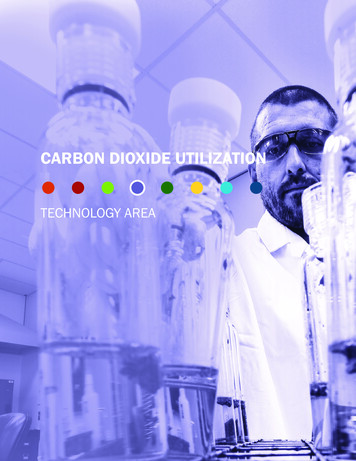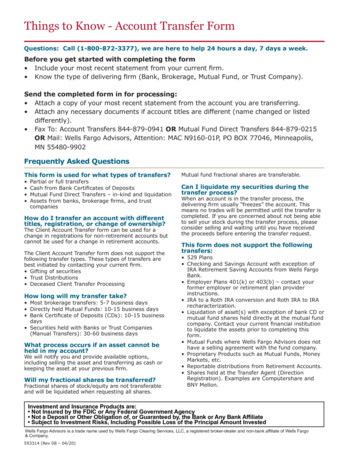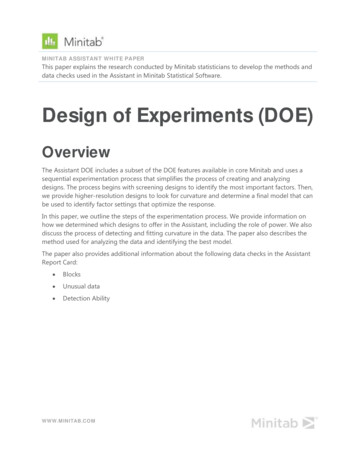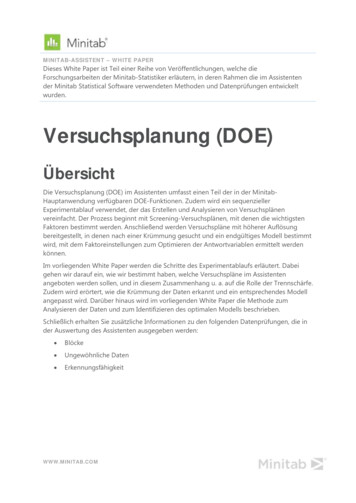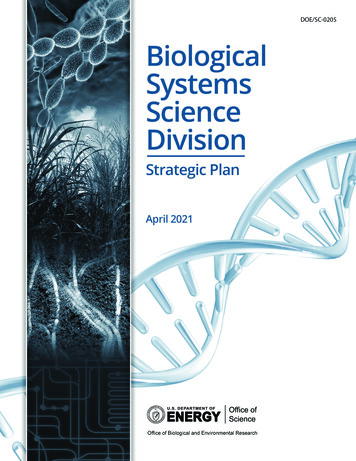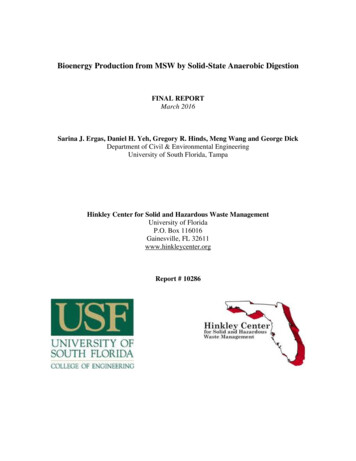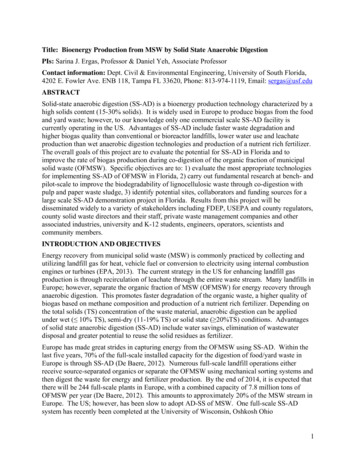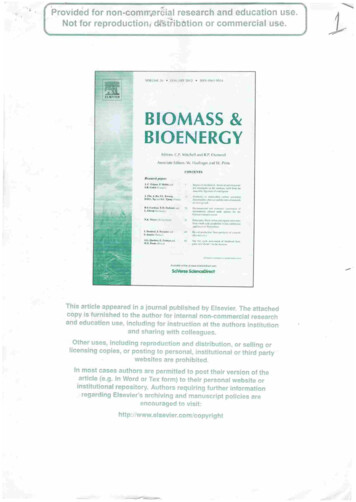
Transcription
DOE Bioenergy Technologies Office (BETO)2019 Project Peer ReviewPACE: Producing Algae for Coproducts andEnergyMarch 2019Advanced Algal SystemsMatthew PosewitzColorado School of MinesThis presentation does not contain any proprietary, confidential, or otherwise restricted information
Goal StatementOverarching Project Goals: Increase algal biomass productivity to 25grams dry weight per meter squared per day(gdw/m2/day) using robust engineered algalstrains to reduce costs 2 . Produce and harvest high-value, high marketdemand coproducts compatible withcontinuous flow, sequential HTP technologyto further reduce biofuel costs. Develop and improve process/engineeringsystems to achieve overall energy return oninvestment (EROI) 3, carbon index 55 gramscarbon dioxide per megajoule (g CO2/mJ).Project Outcome: Combined integration of cultivation,harvesting, processing and geneticengineering improvements to increase arealproductivity resulting in an increased EROIand lower fuel costs.Relevance to the Biofuels Industry Deployment of engineered strains in algalcultivation testbeds to assess productivityimprovements in large scale outdoor facilities. Highly integrated process incorporatingstrain/cultivation improvements through finalalgal crude production that approaches a 2barrel of algal crude per day.
Quad Chart OverviewBarriers addressedTimeline The PACE project specifically addressesBETO challenges in algal BiomassAvailability/Cost (Aft-A) and BiomassGenetics and Development (Aft-C).Project start date: April 1, 2016Project end date: March 31, 2019 plus 1year no-cost extensionPercent complete: 85%Total CostsPre FY17**DOEFundedProjectCostShare*FY 17CostsFY 18Costs 555,353 6,092,727 5,724,344TotalPlannedFunding (FY19-ProjectEnd Date) 12,372,425 299K (54%) 2,307K(38%) 2,847K(50%) 5,452,187CSM (44%) 132KLANL (24%) 1,432KLANL (24%) 1,484,KLANL (26%) 3,047,812LANL (25%) 10KPNNL (2%) 390KPNNL (6 %) 100KPNNL (2%) 500,000.00PNNL (4%) 114,991(21%) 1,963,563(32%) 1,293,871(23%) 3,372,425(27%)ObjectiveImprove areal biomass productivities and enablethe production of high-value co-products usingstrain engineering. Integrate cultivation/processingadvances to lower the cost of algal derivedbiofuels.End of Project Goal Engineered algal strains with enhancedbiomass yields, the ability to synthesize highvalue co-products and/or improved cropstability that attain yields of 25 g/m2/d and areable to accumulate high-value co-products tooffset production costs.Improve cultivation, harvesting, andprocessing technologies to improve theeconomics of converting algal biomass to fuelsusing hydrothermal processing technologies.3
Quad Chart OverviewPACE PartnerSubcontract: Washington State UniversitySubcontract: Arizona State UniversitySubcontract: Colorado State UniversitySubcontract: New Mexico ConsortiumSubcontract: Pan PacificSubcontract: GenifuelSubcontract: RelianceSubcontract: SonosepDOE 360,760 914,141 236,640 1,261,948 979,892 173,959 250,000 411,534CO Energy Research Collaboratory (CERC) Cost Share 90,190 210,798 262,984 345,284 4,868 2,087,581 102,884-TOTAL 4,588,874.00 248,491 3,353,080.004
1 - Project OverviewProject leverages strain improvement technologies from NAABB andstate-of-the-art outdoor culturing and processing facilities at RelianceIndustriesImprove Biomass Yield:o Measure lipid/carbohydrate accumulation in relevant cultures to select for downstream characterizationand optimize profitability.o Improve CO2 utilization to increase yield 30%.o Increase sink strength to increase yield 20%.o Develop crop-protection technologies to reduce possible pond crashes.o Stack value-added traits to give 50% yield increase.Produce Co-products: Produce and harvest higher-value co-products compatible with continuous flow,sequential HTP technology to reduce biofuel costs.o Develop GM algae to produce guar gum.o Produce 2-phenylethanol (PEA) glucoside (PEA Glc).Improve and Optimize Integrated Process: Develop and improve process integration and engineeringsystems to achieve overall EROI 3, carbon index 55 g CO2/mJ, and a nearly 2-fold reduction in fuel cost to 5.00 gallon of gasoline equivalent (gge).oooooooComparing and contrasting large-scale outdoor cultivation systems.Develop and evaluate ultrasonic harvester.Develop and evaluate sequential, continuous flow HTP.Evaluate outdoor-relevant media optionsIntegrated testing at commercial pilot scale.Co-product, biocrude, feedstock and fuel evaluation.Perform life cycle assessment (LCA) and techno-economic analysis (TEA).5
2 – PACE ManagementPartners Matthew PosewitzActing-DirectorNorman LewisAssociate DirectorDavid BruceLANLFinancialDirectorNorman LewisScientificDirectorManagement TeamMatthew Posewitz, Norman Lewis, Jim Oyler,Taraka Dale, Eric Dunlop, Ramesh BhujadeJim OylerEngineeringDirectorShawnStarkenburgTeam Lead –Biomass and coproductsPosewitzTwaryLewisNegiEric DunlopTEA/LCA DirectorTaraka Dale Taraka DaleCultiv./HarvestDirectorColorado SchoolMinesLANLReliance Industries LtdArizona St. Univ.Colorado St. Univ.GenifuelWashington St. Univ.Pan PacificPNNLSonosepRamesh BhujadeProcess ScalingDirectorAnthony MarcheseTeam Lead –Cultivation andHarvestingTeam Lead - ProcessImprovement owenOylerBhujadeAndersonDunlopChelliah
2 – Approach (Management) Monthly PACE ZOOM meeting on research highlightsand progress, and management issues. Monthly specialized meetings to address uniquechallenges.– Algae transformation group meetings– Cultivation group meetings– Processing group meetings Quarterly survey and reporting on progress towardsmeeting all milestones and deliverables. Annual all hands meeting with review and feedback fromBETO. Management Team Oversight.7
2 – Approach (Technical) Major Challenges:– Developing genetic transformation systems and stacking gene traits forChlorella sorokiniana and other “industrial algae”.– Producing and sequentially extracting coproducts (guar and 2phenylethanol glucoside) from biocrude to offset the cost of biofuelproduction.– Improving cultivation and protection strategies to increase biomassyields.– Developing efficient algal harvesting and processing to biofueltechnologies. Major Success Indicators:– Overall EROI 3.– Carbon index 55 g CO2/mJ.– Increase in areal biomass production to 25 g/m2/d.8
3 – Technical Accomplishments/ Progress/Results:Shifting Biochemical Composition in C. sorokinianaShift carbon storage in C. sorokiniana in greenhouse mini-ponds Nutrient depletion, salinity adaptation, genetic modification Proximate analysis using NREL/ATP3methodsBiochemical composition isimportant for reaching BETO’sbiofuel intermediate targets and formeeting the PACE project goals Generate cultures with varyingbiochemical composition Outcome: Increased carbon storageobserved in salt adapted and GM C.sorokiniana Ongoing: Develop model for selectingstrains with lowest cost/gge based onproductivity and biochemical composition
3 – Technical Accomplishments/Progress/Results: Enhanced CO2 Levels Subtask: Enhance Chloroplast CO2 Levels–Design, construct, and transform improved Chlorella sorokiniana (or Nannochloropsis)genetic cassettes for coordinated gene expression of multiple selection reporters and genesof interest. Validate genomic integration and gene expression after optimized transformation. We have generated five different backbone vectorsfor overexpression in Chlorella and three forNannochloropsis (various promoters, linkers,antibiotic cassettes). Using this molecular toolbox, we havegenerated independent transgenics for fiveCCM genes in Chlorella and one in10Nannochloropsis.
3
Quad Chart Overview Timeline Project start date: April 1, 2016 Project end date: March 31, 2019 plus 1 year no-cost extension Percent complete: 85% 3 Total Costs Pre FY17** . Management Team Matthew Posewitz, Norman Lewis, Jim Oyler, Taraka Dale, Eric Dunlop, Ramesh Bhujade Jim Oyler Engineering Director Norman Lewis Scientific

